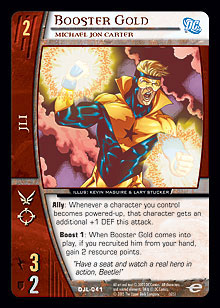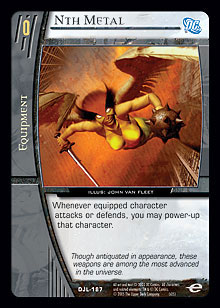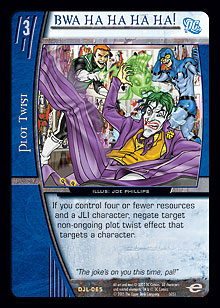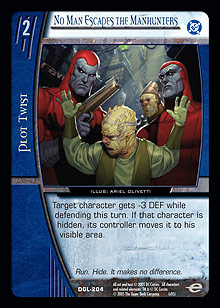
Introduction and History
Before Pro Circuit San Francisco, many players believed that Silver Age would be the most diverse format Vs. System had ever seen. Although decks like G’Lock and AGL were predicted to be played in large numbers, the absence of the powerful Origins cards allowed previously untouchable decks to become viable. Players all over the world began innovating with long-forgotten teams and archetypes, hoping they could make a difference in a format where Doom and the Titans no longer existed. In the end, Ivy League, Squadron variants, and Good Guys were the most-played decks on the Pro Circuit.
Of those three decks, the Ivy League discard one is certainly the most interesting, as the concept of hand disruption hadn’t been very viable in a game where you draw two cards per turn. However, Upper Deck recently banned Justice League of Arkham, which will destroy the deck’s entire discard engine as of July 1. Squadron was inevitably present; Vidianto Wijaya proved how explosive the deck was when he took first place with it at Pro Circuit Atlanta. Good Guys has only placed in one major event, and the deck has often been written off as poor compared to other decks in the format. And while I’m not claiming that it’s the best deck, it’s certainly better than many people give it credit for. Good Guys’ ability to pump its characters to massive stats early and the flexibility it gains by its various search cards makes it a force to be reckoned with by rush and control decks alike.
 Good Guys first appeared on the competitive scene during $10K Sydney 2006, where James White piloted the deck to a fourth place finish. The deck utilized power-up effects such as Magnificent Seven and Nth Metal to take advantage of impressive ally abilities that affected combat or searched the deck for other useful cards. With characters like Connor Hawke ◊ Green Arrow, Katar Hol ◊ Hawkman, and Thanagarian Enforcer, the deck could generate high ATK values in the early turns of the game, making the JLA / JLI team-up the perfect deck to be built around the rush archetype. Other flexible search effects such as Kooey Kooey Kooey and Hero’s Welcome added to the deck’s consistency and versatility, both of which are important aspects of any top-tier concoction. Since then, Good Guys has received a boost from the Infinite Crisis set, and now the deck’s ability to exploit the ally mechanic is stronger than ever.
Good Guys first appeared on the competitive scene during $10K Sydney 2006, where James White piloted the deck to a fourth place finish. The deck utilized power-up effects such as Magnificent Seven and Nth Metal to take advantage of impressive ally abilities that affected combat or searched the deck for other useful cards. With characters like Connor Hawke ◊ Green Arrow, Katar Hol ◊ Hawkman, and Thanagarian Enforcer, the deck could generate high ATK values in the early turns of the game, making the JLA / JLI team-up the perfect deck to be built around the rush archetype. Other flexible search effects such as Kooey Kooey Kooey and Hero’s Welcome added to the deck’s consistency and versatility, both of which are important aspects of any top-tier concoction. Since then, Good Guys has received a boost from the Infinite Crisis set, and now the deck’s ability to exploit the ally mechanic is stronger than ever.
The Build
For Pro Circuit San Francisco, my teammate decided to play Good Guys. While no Good Guys decks finished in the Top 8, quite a few of them finished 7-3 or better after Day 1. Here is the list my teammate played in San Francisco:
Characters
4 Sue Dibny, Charismatic Coordinator
4 Ted Kord ◊ Blue Beetle, Heir of the Scarab
4 Mr. Mxyzptlk, Troublesome Trickster
1 Mikado and Mosha, Angels of Destruction
4 Booster Gold, Michael Jon Carter
4 Shayera Thal ◊ Hawkwoman, Thanagarian Enforcer
2 Katar Hol ◊ Hawkman, Eternal Hero
2 Katar Hol ◊ Hawkman, Thanagarian Enforcer
2 Fire, Beatriz DaCosta
2 John Henry Irons ◊ Steel, Steel-Drivin’ Man
Plot Twists
4 World’s Greatest Heroes, Team-Up
4 Magnificent Seven
4 BWA HA HA HA HA!
4 Enemy of My Enemy
1 No Man Escapes the Manhunters
1 Hero’s Welcome
1 Mourn for the Lost
Locations
4 Kooey Kooey Kooey
3 Slaughter Swamp
Equipment
4 Nth Metal
1 Light Armor
 Despite the twenty-nine-character curve, with a proper mulligan, the deck can usually hit drops 1 through 5 without too much trouble. The strategy behind the character selection is each character’s ability to search for another. For example, Ted Kord ◊ Blue Beetle and Sue Dibny will both search for Booster Gold, and Shayera Thal ◊ Hawkwoman can search for either version of Katar Hol ◊ Hawkman. Good Guys’ mulligan condition should be Booster Gold or a way to get him, which essentially means that if you see a 1- or 2-drop, you should keep your opening hand.
Despite the twenty-nine-character curve, with a proper mulligan, the deck can usually hit drops 1 through 5 without too much trouble. The strategy behind the character selection is each character’s ability to search for another. For example, Ted Kord ◊ Blue Beetle and Sue Dibny will both search for Booster Gold, and Shayera Thal ◊ Hawkwoman can search for either version of Katar Hol ◊ Hawkman. Good Guys’ mulligan condition should be Booster Gold or a way to get him, which essentially means that if you see a 1- or 2-drop, you should keep your opening hand.
While it may appear as if you’re only playing four copies of your 3-drop, in reality, you’re playing nine. Four copies of Enemy of My Enemy and a single copy of Hero’s Welcome add to the consistency of hitting your 3-drop, so even if you don’t draw into Shayera Thal ◊ Hawkwoman by turn 3, you’ll probably draw into one of those five cards that can search for her. Then, once she’s in play, she searches out either version of Katar Hol through her ally effect. Finally, if you haven’t drawn into either Fire or John Henry Irons by turn 5, you will probably have a Kooey Kooey Kooey that you can use to search one of them out. Or, you could draw into any of the search cards I mentioned earlier, creating the effect of running about twelve 5-drops. In the worst case scenario, you will have to play two character searchers throughout the course of the game. More often than not, you won’t need to play any, and when you draw into excess search cards, you can use them to search out utility cards like Mikado and Mosha or Mr. Mxyzptlk.
The Strategy
In a deck where your entire game plan consists of power-ups, a card like Nth Metal is ridiculously strong. Ideally, you want to play a copy of Nth Metal on every character you recruit except your 1-drops and John Henry Irons, who should be equipped with a Light Armor instead. Ted Kord ◊ Blue Beetle is always your preferred 1-drop because he can search for an Nth Metal every turn he’s in play. Without him, it’s unlikely that you will have an Nth Metal ready for every character you recruit. Therefore, it’s important to make sure that you use all the equipment you draw to the fullest potential. You should always save an Nth Metal for Shayera Thal ◊ Hawkwoman on turn 3, even if it means not equipping it to Booster Gold on turn 2. Her ally effect allows you to search for more copies of Nth Metal, and while her effect would trigger if Booster Gold became powered-up, a 6 ATK / 6 DEF 3-drop is more impressive than a 4 ATK / 4 DEF 2-drop. However, if you have multiple copies of Nth Metal or a Ted Kord ◊ Blue Beetle in play on turn 2, by all means equip Booster Gold.
If it’s not already obvious, you should never recruit Mr. Mxyzptlk or Mikado and Mosha while playing Good Guys; these two cards are only here for their off-the-board effects. A good portion of the cards in this deck require a discard, such as Ted Kord or Shayera Thal, and Mr. Mxyzptlk ensures that you’ll keep a sizable hand. Mikado and Mosha is meant to be used repeatedly with Slaughter Swamp to shut down opposing rush decks or problematic 1-drops.
The deck’s 2- and 3-drops are basically set in stone, seeing as there is only one unique character at each drop. The 4- and 5-drops, however, offer a little more variety. Both the 4- and 5- drop slots are split two and two, which means that none of the characters are backup drops. Rather, you have to know which deck your opponent is playing (which you should hopefully be able to decipher by turn 4) and decide which card you should search for.
 While playing a rush deck, such as AGL, Squadron, or Faces, you want to search for Katar Hol ◊ Hawkman, Eternal Hero. If an extra +1 DEF from Booster Gold is good, then a similar effect from the new Hawkman is crazy. If they’re both on the board at the same time, then you get an amazing +3 DEF every time a character equipped with Nth Metal enters combat. Naturally, rush decks play lots of characters with high ATK values, which makes stunbacks almost inevitable even while attacking down the curve. Katar Hol ◊ Hawkman ensures that you won’t be stunned back on offense and will occasionally allow you to stonewall attacks while defending on turn 5.
While playing a rush deck, such as AGL, Squadron, or Faces, you want to search for Katar Hol ◊ Hawkman, Eternal Hero. If an extra +1 DEF from Booster Gold is good, then a similar effect from the new Hawkman is crazy. If they’re both on the board at the same time, then you get an amazing +3 DEF every time a character equipped with Nth Metal enters combat. Naturally, rush decks play lots of characters with high ATK values, which makes stunbacks almost inevitable even while attacking down the curve. Katar Hol ◊ Hawkman ensures that you won’t be stunned back on offense and will occasionally allow you to stonewall attacks while defending on turn 5.
However, against curve decks, you want to search out Katar Hol ◊ Hawkman, Thanagarian Enforcer. While equipped with Nth Metal, he’s 9 ATK / 9 DEF (and if Booster Gold is in play, he’s 9 ATK / 10 DEF), which is the size of an average 5-drop. Aside from having enormous stats, he allows your lower drops to swing up the curve against decks like G’Lock. Gaining board advantage through curve jumping is never a bad thing.
For the 5-drops, you usually have to be content with whatever you draw unless you have a Kooey Kooey Kooey and can choose whom to search for. If given the option, you should play Steel with a Light Armor on turn 5 and Fire on turn 6. Steel’s massive DEF is helpful for keeping your other characters around on turn 5, as that is the turn on which most rush decks attempt to win the game. You want to play Fire on your initiative so that you can take advantage of the combo between her and Steel to burn for the maximum amount of endurance by KO’ing your Nth Metals. With Fire, always be sure to let Nth Metal resolve first before you KO it with Steel so that you burn for 4 points of damage instead of just 2. Attacking and burning all your excess equipment with Steel for Fire’s effect will result in enough damage to kill on turn 6. Because turn 6 is your kill turn, Good Guys prefers the even initiatives.
When it was first suggested by my teammate, I believed that Light Armor was vastly inferior to Atlantean Trident or Flamethrower. Recruiting Steel and getting a 1-cost equipment into play for free is a ridiculous effect, so you might as well get the most you can out of it. While Light Armor might not give +1 ATK / +1 DEF counters or burn for 5 endurance, it does a better all-around job as a card than Atlantean Trident. If you draw into Trident anytime before turn 5, it will only be useful as a discard to Slaughter Swamp. Light Armor is better than Trident here because it can be used as a vanilla +3 ATK pump, and once it’s in the KO’d pile, Steel can grab it when he comes into play. Light Armor will never be a dead card, and you don’t want to be playing a card that serves no purpose if you accomplish your deck’s goal, which in Good Guys’ case is to curve out. Atlantean Trident is better than Light Armor if you miss a drop and have to play a smaller character and an equipment, but you shouldn’t be planning for this to happen because the deck rarely misses drops. In the end, Light Armor is more flexible than Atlantean Trident, and although it gives a slightly smaller bonus than Trident over time, it’s not as situational.
Mourn for the Lost was included in Good Guys to stop Unmasked. As you can probably guess, Unmasked annihilates decks based on power-up effects, and while testing for PC: San Francisco, we were afraid that Injustice Gang would show up in decent numbers. Now that the metagame has been showcased, I don’t think it’s necessary to run Mourn for the Lost anymore, simply because it’s so narrow and Unmasked isn’t in that many decks.
Finally, the lone copy of No Man Escapes the Manhunters may seem a little strange. While it has its uses against Checkmate-based decks that run Ahmed Samsarra, the main purpose of No Man Escapes the Manhunters is to move the problematic character Kang, Kang Cobra to the visible area. It can also be used against other concealed characters, such as Chomin or Merlyn, after an opposing Rook Control. Sure, Good Guys could run a more generic anti-hidden effect, but No Man can be used against any deck whether it runs hidden characters or not. A single copy is sufficient for being searched out to deal with concealed characters.
Matchups
Mexican Hardware Store:
This matchup is actually really easy. Comparing ATK values, your characters are about equal to theirs, but you have a massive defensive advantage. It’s very easy to stonewall important attacks on turn 5, and it’s also easy to recover from a bad draw. The only cards necessary for this matchup are your characters; you can often win if you draw only a single Nth Metal. Watch out for Jester, though—you don’t want him stealing your equipment in the middle of an attack. My other word of caution for this matchup is to watch out for Die for Darkseid! when it’s played defensively. It’s often tempting to load all of your power-up effects onto a single character in the hope of causing game-winning breakthrough, but Die for Darkseid! will make all those pumps go to waste.
G’Lock:
 Throughout the course of the game, you’ll see that your characters are significantly bigger than theirs are. The old version of Katar Hol is important in this matchup for adding extra ATK to ensure that Malvolio and Katma Tui get stunned. Also, Slaughter Swamp can prevent all Dr. Light activations, leaving your opponent with a relatively small field and weak defenses. To top it all off, BWA HA HA HA HA! negates Helping Hand and Lanterns in Love, leaving Rain of Acorns as the only card you may have trouble with. Even so, as long as the game isn’t pulled out to turn 8, this matchup is heavily in Good Guys’ favor.
Throughout the course of the game, you’ll see that your characters are significantly bigger than theirs are. The old version of Katar Hol is important in this matchup for adding extra ATK to ensure that Malvolio and Katma Tui get stunned. Also, Slaughter Swamp can prevent all Dr. Light activations, leaving your opponent with a relatively small field and weak defenses. To top it all off, BWA HA HA HA HA! negates Helping Hand and Lanterns in Love, leaving Rain of Acorns as the only card you may have trouble with. Even so, as long as the game isn’t pulled out to turn 8, this matchup is heavily in Good Guys’ favor.
Discard:
The discard deck is actually Good Guys’ worst matchup. Even after teching in a single copy of Sage, Xavier’s Secret Weapon, this matchup remains a tricky one. Deadshot can KO Sage, and there’s a chance you won’t have a way to search for her on turn 3. However, as luck would have it, Justice League of Arkham will be banned on July 1. It’s certainly good news for anyone playing Good Guys, as Sage is no longer required and tech slots can be used for other important matchups.
Checkmate / League of Assassins:
Checkmate-based decks start off pretty slowly because they recruit their 3-drop into the hidden area and often neglect to play 1-drops. For the first three turns of the game, your dominance over both the board and the endurance totals will be obvious . . . almost misleading. When Merlyn hits the field on turn 4, he will probably be shipped to the hidden area via Rook Control, allowing him to shoot down your second-biggest guy every turn. It’s okay if you lose Shayera Thal ◊ Hawkwoman, but if Katar Hol ◊ Hawkman gets KO’d, then you’re in big trouble. The only way to prevent Merlyn from destroying your board turn after turn is to get rid of his cosmic counter by stunning him. Because he will most likely be concealed, No Man Escapes the Manhunters can yank him out of the hidden area so that any of your characters can attack him. Once you get Merlyn’s counter off, it’s pretty easy to push through for however much endurance your opponent still has left. Just make sure that you factor Checkmate Safe House into your attack plans.
Checkmate / Villains United:
This deck isn’t too different from Checkmate / League, except for the fact that you don’t have to deal with Merlyn. As with the Mexican Hardware Store matchup, don’t save all of your cards for one big attack, because The Science Spire will ruin your day. Watch out for Phantom Zone, because it can remove a Slaughter Swamp target or Mr. Mxyzptlk. There’s no real way to get rid of it, so once it’s face up, you just have to play around it. If you ever see a Knightmare Scenario, don’t hesitate to use BWA HA HA HA HA!, because it’s the plot twist that targets characters. Other than that, this matchup is almost identical to the Checkmate / League of Assassins one. Hit hard and fast in the early turns and deal the remaining damage through Fire on turn 5 or 6.
The Mirror:
The mirror is by far the most complicated matchup for Good Guys. With so many power-ups flying around, it’s hard to calculate how big a certain character will be in any given attack The most important card in this matchup is Ted Kord ◊ Blue Beetle, because if you can guarantee that you’ll see an Nth Metal every turn, you’ll have a huge advantage. It’s also important to do your best to stay at four resources so that you can use BWA HA HA HA HA! on Magnificent Seven. I’m still undecided about which Katar Hol ◊ Hawkman is better in this matchup, but I’m leaning toward the Thanagarian Enforcer version. The game will drag out to turn 7 pretty often, but I wouldn’t advocate taking the odd initiatives just for this matchup. It’s still very winnable on evens. Don’t make risky attacks and don’t try to stonewall unless you’re absolutely certain that you can stop the attack. Basically, risky plays that fail will turn the tide of this matchup, so play it safe on offense and defense.
Conclusions
 After seeing the popular decks in the Silver Age metagame, the Good Guys build will have to be altered. Mourn for the Lost is no longer needed because Unmasked isn’t present in any of the recent top decks. More copies of No Man Escapes the Manhunters need to be played to deal with the presence of Ahmed Samsarra and other hidden characters. The BWA HA HA HA HA! count could also be lowered, since the card is very limited in its uses against Checkmate decks. An alternate 4-drop (one not named Katar Hol) might have to be played to ensure that you retain board dominance if you have to use Kooey Kooey Kooey on turn 4. These are only small changes, but in a good deck, every card has a purpose, and Good Guys is no exception.
After seeing the popular decks in the Silver Age metagame, the Good Guys build will have to be altered. Mourn for the Lost is no longer needed because Unmasked isn’t present in any of the recent top decks. More copies of No Man Escapes the Manhunters need to be played to deal with the presence of Ahmed Samsarra and other hidden characters. The BWA HA HA HA HA! count could also be lowered, since the card is very limited in its uses against Checkmate decks. An alternate 4-drop (one not named Katar Hol) might have to be played to ensure that you retain board dominance if you have to use Kooey Kooey Kooey on turn 4. These are only small changes, but in a good deck, every card has a purpose, and Good Guys is no exception.
With the banning of Justice League of Arkham, the Silver Age format is even more wide open than it was at Pro Circuit San Francisco. Good Guys has the ability to out-pump and stonewall rush decks, while at the same time, it has the quickness and power to beat control decks before they can drag the game out to the later turns. The powerful search effects for both character and non-character cards alike make Good Guys consistent and allow “silver bullet” cards to be played for specific matchups. As the middle ground between rush and curve decks, Good Guys is a strong choice for the upcoming PCQ season.